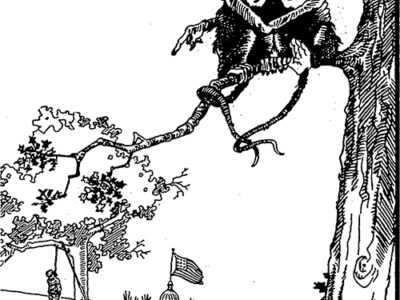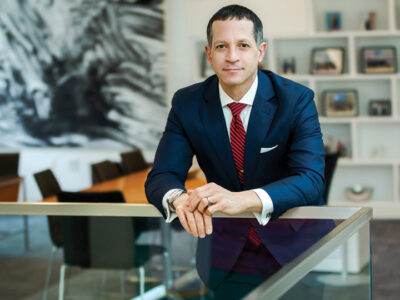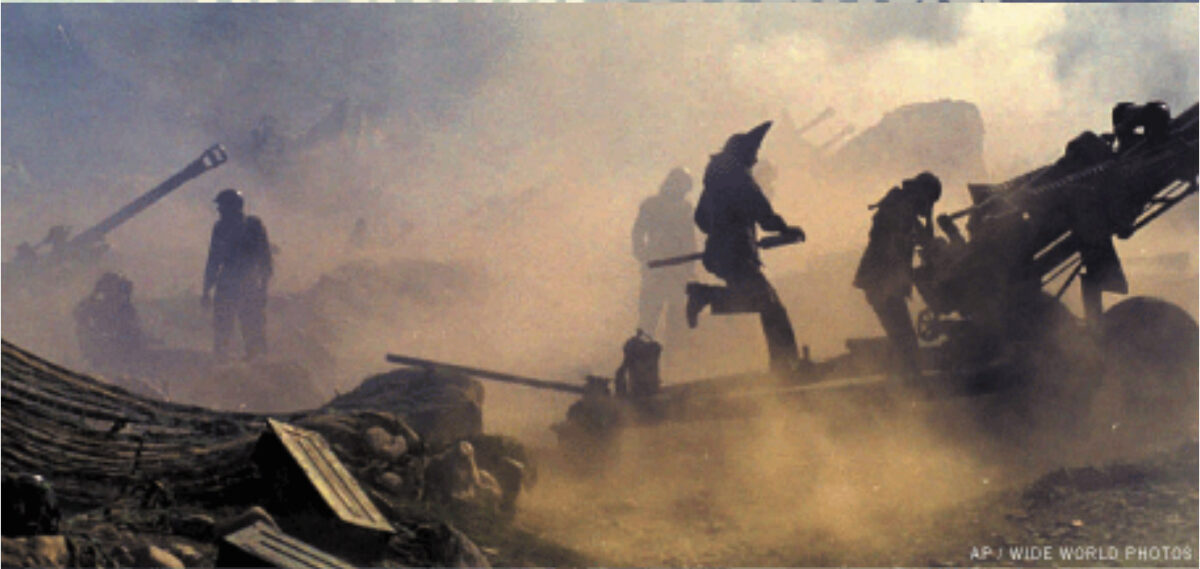
A recent symposium at Penn probed the causes, symptoms and solutions of ethnic warfare.
By Samuel Hughes
“The Challenge of Ethnopolitical Conflict: Can the World Cope?” was sponsored by the School of Arts and Sciences, funded by the late John W. Merriam W’31 and held in the newly revamped Houston Hall on November 29. In a sense, it had its origins in 1997, when Dr. Martin E. P. Seligman Gr’67, the Fox Leadership Professor of Psychology who was then president of the American Psychological Association, announced an initiative to “create a profession for psychologists of devoting their lives to the prediction and understanding of ethnopolitical warfare,” as he put it recently.
One result of that initiative was the Solomon Asch Center for Study of Ethnopolitical Conflict at Penn, which was founded two years ago to advance understanding of that conflict and to find ways to treat its effects. And according to Dr. Walter Licht, the professor of history who served as chair of the symposium’s faculty organizing committee, it was “the very creation” of the center that led to the symposium.
“Surely, we say, there is no human instinct for intergroup violence,” Dr. Melvin Konner was saying during the opening session of the Merriam Symposium on ethnopolitical conflict. “Maybe not—but here is what there is: Hunger, greed and lust bring groups into competition with one another. Desire expands human numbers, intensifying competition. Fear of violence stimulates violence. Frustration induces rage. Mimesis causes mirror-image negative emotions. Stereotype dualities dichotomize the social world. Individual will and consciousness submerge in crowd-psychology emotional contagion. Obedience to authority takes the place of conscience. Insular groups exhibit fierce internal cohesion. Positive ideals—loyalty, sacrifice, heroism—serve the worst possible ends.”
Konner, the Samuel Chandler Dobbs Professor of Anthropology and associate professor of psychiatry and neurology at Emory University, paused for a moment. “If we want to decline to call this instinct, fine,” he concluded. “Call it what you will, but recognize that as a partial answer to the question posed at the outset: If we are not by nature violent creatures, why do we seem continually to create situations that lead to violence?”
The question hanging over the symposium was: Can the world cope? The answers were complex, measured and often sobering. It lasted all day and featured six panels, each made up of leading thinkers on the issue at hand. The opening session probed the larger questions of ethnopolitical conflict through the perspectives of anthropology, political science and psychology. Four panels focused on Jerusalem, Kosovo, Kashmir and Rwanda. The closing one examined ways to build peace and speed the process of reconciliation.
Even as the opening panel convened in the “safe confines” of Houston Hall, “conflicts between peoples of different linguistic, religious and spatial backgrounds persist,” noted Dr. Walter Licht, the professor of history and associate dean of SAS who chaired the opening panel. Where, he asked rhetorically, “can we find the seeds of this hostility?”
Some can be found in the structures of political institutions. The desire for a nation-state of one’s own ethnic group is, as one panelist noted, at least as old as the Old Testament. But very few nations are comprised of just one ethnic group or nationality, and that multiplicity usually leads to some form of federal political system. For Dr. Brendan O’Leary, the key question is whether the existence of “apparently stable, multi-national and poly-ethnic federal democratic states” proves that the strong pressure for each nation to have its own state is “not overwhelming.”
Federalism and nationalism are not necessarily incompatible in principle, said O’Leary, professor of political science at the London School of Economics and co-author of The Politics of Antagonism: Understanding Northern Ireland. The fact that people might be “governed by members of other nationalities does not violate the nationalist principle as long as the institutional arrangements are a byproduct of genuine consent of some form.”
But certain brands of nationalism and federalism are indeed incompatible, especially if there is a struggle for power among different ethnic peoples. Acknowledging that it “will sound Nazi,” O’Leary laid out his theory: that a “stable, democratic, procedurally majoritarian federation must have a Staatsvolk: a national or ethnic people who are demographically and electorally dominant.” After showing a slide of democratic federations around the world in 1998, complete with their relevant Staatsvolk, O’Leary said that “all of the democratic federations which have lasted over 30 years appear to have a Staatsvolk on this definition” (though he acknowledged that, “to use a horribly fashionable term, a Staatsvolk is a social construct”). The United States, he noted, was the “first national federation” in world history, having been “built around a White Anglo-Saxon Protestant core of former British sectors” who “had to be a majority in all states before the federation could expand.” Its history, he stressed, is not one of multinational federalism.
“The implicit micro-foundations of this theory is that dominant people can afford to be more generous and they can afford to be relaxed about the form of territorial government,” he added. And where a Staatsvolk does not exist, “things may appear to be more precarious.”
According to his data, most stable majoritarian federations have fewer than two effective ethnic groups, meaning that one ethnic group is clearly predominant. But there are, he pointed out, some stable federations (such as Switzerland and Canada) “which hover close to two and above,” meaning that power is shared by two or more ethnic groups of relatively equal size, and that those federations thus lack a Staatsvolk. That they are also relatively stable is owing to their use of consociational (power-sharing) institutions “based upon proportional representation of groups with group autonomy in culture and veto rights.”
For all its flaws, O’Leary held up the European Union and its consociational arrangements as a successful model of a federation. It “preserves national autonomy for members; gives national members veto rights; insists on proportional representation of national citizens in all of the key institutions of the European Union; and operates with a system of highly slow and painful consensual executive decision-making.”
If his Staatsvolk theory is correct, he noted, “it has implications for what we should prescribe to other parts of the world,” he warned. “By and large, when Americans go abroad to prescribe how to manage national and ethnic questions, they say you should integrate peoples; you should let them voluntarily assimilate if you respect our best historic practice; but you should also think of federal forms. And my argument is that the export of federalism, without careful attention to the nature of the demographic and electoral balance between ethnic groups, may well lead to erroneous prescriptions.”
For Dr. Clark McCauley Gr’67, professor of psychology at Bryn Mawr College and co-director of the Solomon Asch Center for Study of Ethnopolitical Conflict at Penn, the horrific “big killing” that sometimes characterizes ethnic violence is seldom the result of “impulse or hate” suddenly boiling over at a despised ethnic group. It requires something more chilling: organization and government support.
“With organization, big killing does not require large numbers of killers,” he said. Nor are the killers “abnormal” personalities: “Big killing depends on recruiting normal people to kill and kill indiscriminately.”
Rather, McCauley said, the psychology of killing involves “individual-level mechanisms of desensitization, dehumanization of the enemy, and intense group dynamics among the killers that creates a social reality in which killing is morally acceptable and necessary.”
A “considerably more mysterious” phenomenon, he added, is the “psychology of the pyramid,” in that the “apex of the killers in ethnic conflict requires the sympathy and support of a much larger number. The psychology of the pyramid is, I think, the psychology of group identification, which I understand to be caring about the outcomes of a group.”
Ethnic nationalism is “positive identification with an ethnic group combined with the idea that ethnic groups should have a state for other political rights,” McCauley explained. And the “five political characteristics of ethnic conflict” that a psychology of ethnic identification should examine are that:
• People are willing to sacrifice their lives, money and almost everything else for something as “faceless as an ethnic or national group.”
• Much violence is directed not just at members of other ethnic groups but at “deviants within ethnic groups” when there is conflict.
• The “perceived threat to the ethnic group” may well be the “big mobilizer of ethnic identification,” which is why the conflict is “the most intractable” in places that have “double minorities”— such as Sri Lanka, Northern Ireland and Israel—where “both sides can realistically see themselves as an endangered minority.” In his opinion, “fear rather than hate is the dominant emotion in ethnic group conflict.”
• “Politically, ethnicity seems to be especially powerful,” and one of the “great surprises of the 20th century” is that it’s “easier to mobilize people with ethnicity than other kinds of identities.”
• “History is somehow crucial to people involved in mobilizing for ethnic conflict. Nations care about their history, however mythical the history might be.”
People who care about their ethnic group for economic or material gain may be less likely to sacrifice for the group than individuals who care about their group for its “social-reality value, for the moral culture that makes sense of the world and the individual’s place in it,” McCauley noted. And recent research has shown that “shared threat is a particularly potent source of group cohesion in face-to-face groups.”
Some researchers have suggested that human brains have a “module for descent-based categories of people that interprets people in terms of categories defined by essence, race,” said McCauley. Ethnicity—or even culture—may thus be “essentialized” in such a way that “even members of a group who do not show group-typical characteristics are assumed to have, nevertheless, the hidden essence, the tendencies of their descent group.” And once a group is seen as descent-based, “then the perception of common essence can facilitate both positive identification with the in-group and negative identification with an out-group of a different essence. The out-group is not, after all, quite human in the way the in-group is.”
He offered another observation from what is known as “terror-management theory.” Given that humans are the only animals that know they’re going to die, he said, “our defense against existential terror is our membership in and contribution to a group that will go on after our individual death.”
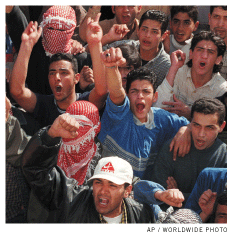
Jerusalem: Misconceptions and Original Sins
Perhaps no city on the planet has endured so many centuries of ethnic and religious bloodshed as Jerusalem, the cradle of the world’s three great monotheistic religions. The panel examining the current strife had a somewhat Israel-centric focus, not because the two speakers were overly supportive of the 52-year-old nation-state but because, in their opinion, only Israel could make certain changes needed for peace.
Dr. Ian Lustick, professor of political science, began by reminding the audience that a great deal of ethnopolitical conflict is “not the conflict of interest between the two sides but rather is the result of conflicts inside one or both of the sides.” Only by understanding the dynamics of internal Israeli politics “can we understand how much of the problem between Jews and Palestinians is actually a reflection of a struggle inside of Israel,” he added. Part of that struggle has revolved around a number of “misconceptions” regarding Yerushalayim (the Hebrew word for Jerusalem), he argued, and within those misconceptions are the seeds of a peace accord.
The first misconception is that “a unified Yerushalayim under Jewish sovereignty has always been a powerful and central element in Zionism.” In fact, he said, back in the 1920s and ’30s, most Zionist leaders didn’t want their capital there, and he showed several maps and outlines from the 1930s, ’40s, ’60s and ’70s depicting the many different configurations of the city that were approved by Zionist leaders and/or the Israeli government.
“So what we’re seeing is a very malleable border, not a set border, something that can be changed and manipulated in response to what the political needs of the moment are or the political opportunities are perceived to be.” More recent maps have had similar goals: “to make it seem as if this large, completely new boundary was a traditional, united Yerushalayim [for which] Jews have been yearning for millennia.”
These misconceptions were “not an accident,” Lustick argued, but were pushed by the “extreme Right” in Israel. “Their idea is this: ‘We can never convince a majority of Israeli Jews that they ought to fight and die for Nablus or Jericho or Ramallah. [Instead,] we can convince them that this huge piece of the West Bank, including the biggest Palestinian city, is Yerushalayim and they can’t give up their right hand for it,” knowing that the Palestinians “will never accept a state without al-Quds [Arab Jerusalem].”
Later, in the question-and-answer session, Lustick talked about the polling discrepancies on the subject of Jerusalem among polls of Israeli Jews: “If you ask them blindly, ‘Do you agree that we should negotiate about Yerushalayim?’ over 90 percent will say, ‘No—no negotiations.’ If you say, ‘To avoid an Arab majority in Yerushalayim, do you support redefining the city limits so Arab settlements will be outside the city?’ Sixty percent said ‘Yes.’ And that was in 1995. So, in fact, the feeling of disgust and fear of the other is what actually makes it possible for Israel to politically move toward a separation” between West (Israeli) and East (Arab) Jerusalem—and thus toward a peace treaty as well. (Note: that was 10 weeks before Ariel Sharon was elected prime minister.)
For Muhammad Hallaj, a member of the Palestinian National Council and former director of the Center for Policy Analysis on Palestine, the conflict in Jerusalem is not motivated by ethnicity per se. Rather, he argued, “It’s a conflict between a people who are occupied by another people. And the occupied always resist the occupier.
“There has been a consensus for a long time that if the peace process in the Middle East founders, the rock against which it will crash will be the issue of Jerusalem,” he said. “Jerusalem has become a question of ‘To be or not to be’ for the Jewish state. This is the way it has been successfully portrayed in most of the world.”
What is less understood in the West, he said, “is how important Jerusalem is to the Palestinians.” While acknowledging that “Jerusalem has religious and emotional importance to Jews and to the Jewish state—there’s no question about that and there’s no sense denying that fact”—Hallaj maintained that it is “more important to the Palestinians than it is to the Israelis.” In addition to the religious and emotional ties, he argued that the ancient city is important to Palestinians for a number of reasons:
• It is the largest Palestinian city with the “biggest concentration of the Palestinian population in the region,” and home to the “bulk of the Palestinian elite.” It is also the “major center of Palestinian national life,” home to most Palestinian newspapers, the only Palestinian theater, the biggest Palestinian hospital, and so forth. Geographically, Jerusalem —especially the current “expanded Jerusalem”—is indispensable to the viability of Palestinian national life. “You take Jerusalem out of Palestine, or what is intended to be Palestine, and you pretty much sever it into two discontinuous regions.”
• Jerusalem is the “historic capital of Palestine.” Although many in the West think that the idea of a Palestinian state with Jerusalem as its capital is a political aspiration for the future, “it’s also a recollection of the Palestinian past,” said Hallaj. “I was born in Palestine and Jerusalem was our capital city. There was no Israel.”
• Palestinians have been appointed, and have accepted, the role of custodians of Arab and Muslim interests in Jerusalem.
Though Hallaj stated flatly that further territorial concessions by Palestinians are “not feasible in Jerusalem,” since Israel was “established on 80 percent of Palestinian historic homeland,” he suggested two possibilities. One involves “divided sovereignty over a unified city—in other words, you keep Jerusalem as one city with free movement of people,” with some part under Israeli sovereignty and another part under Palestinian sovereignty. While it may be “a little difficult to work out the constitutional arrangements and the modalities and the details,” he said, “difficult is a lot better than impossible.”
The other possibility, he said, “is to re-divide the city the way it was before Israel occupied the Arab half in 1967.” After all, he said, Jerusalem has been a divided city even since Israel occupied it in 1967. West (Israeli) Jerusalem and East (Arab) Jerusalem may be geographically contiguous, “but in every other way they are worlds apart. You go from East Jerusalem to West Jerusalem, which is a five-minute walking trip, and you jump from Damascus to Budapest.”
While acknowledging that before 1967, Israelis—as “enemy nationals”—were not allowed to go into Old Jerusalem, Hallaj said that “with the advent of peace in the region, there [would be] absolutely no reason for that.”
Later, during the peace-building discussion that concluded the conference, Dr. Joseph Montville—a former U.S. diplomat who now serves as director of the Preventative Diplomacy Program at the Center for Strategic and International Studies in Washington—offered some historical and psychological perspectives on the Israeli-Palestinian conflict.
Israel, he noted, “is a product basically of the Jewish experience in Christian Europe,” a point seldom made in discussions of the region’s problems. “In a sense, the Jews and the Arabs, mostly Muslims, have been made to pay a price for centuries of Christian persecution and brutality towards the Jewish people in Europe,” he said.
Montville cited a number of hawkish Israelis, including former defense minister Ariel Sharon, whose controversial visit to the Temple Mount/Haram al-Sharif added fuel to the recent escalation of fighting (and, ironically, to Sharon’s election as prime minister in February). “Sharon’s view of how Jews defend themselves is to fight as long as necessary … It thinks of sheer, raw survival in a brutal, brutalized world.”
In recent years, Montville said, he has been “trying to communicate to Palestinians this Christian burden of guilt and its consequence on the Zionist movement and the formulation of the Jewish state,” noting that history has “dealt the Palestinians the role of acquiescing in the establishment of and continued existence of the Jewish state.”
He pointed out that Ami Ayalon, a former head of Israel’s internal security service, Shinbet, recently made an “unprecedented declaration about the need to forego the use of strength” and the “necessity for civic integration,” and that Ayalon also made a “very dramatic request” that Israel acknowledge its debt to the Arabs of Palestine from 1948, when Israel was established.
“The first step would be a formal recognition on the part of the government of the price paid by the Palestinians in 1948, including those who became citizens of the state,” he said. “The shadow of 1948 hovers constantly over the Arabs in Israel, and it’s playing a part in the willingness they’ve demonstrated to rebel against the state. An original sin which is not dealt with … is like an internal wound which is not tended to.”
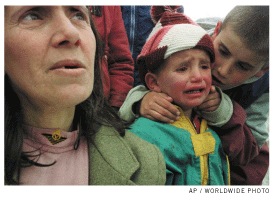
Kosovo: “Very Difficult and Troubling Times” Ahead
Moderator Ben Nathans, the M. Mark and Esther K. Watkins Assistant Professor in the Humanities, noted that the crisis in the Balkans was the only one discussed at the conference to have elicited a direct military response by the international community. But while the NATO intervention in Kosovo—the sustained bombing of Serbia in the spring of 1999—did succeed in ending the oppression of the Kosovar Albanians at the hand of the Serbs, it also sowed the seeds of a new round of conflict, according to historian Ivo Banac and New York Times reporter Christopher Hedges.
Banac, the Bradford Durfee Professor of History at Yale, emphasized that the conflict in Kosovo cannot be looked at in isolation but rather as “part of the end of the second Yugoslav state.” While the wars in Bosnia and Kosovo had many sources, they were both attempts to create ethnically homogeneous states, he said.
Banac traced the increasing oppression of the Albanian Kosovars through the 1980s, and especially in the latter part of the decade as the Serbian dictator Slobodan Milosevic consolidated his power. By 1989, said Banac, Kosovo had gone from relative autonomy under the Tito regime in Yugoslavia to an essentially “apartheid society.” Through much of the 1990s, the response of the ethnic Albanians to this oppression was “infinitely patient and pacific.” Under the leadership of Ibrahim Rugova’s Democratic League of Kosovo, the Kosovars practiced passive resistance, creating a parallel society of schools, hospitals and associations. This approach was discredited in the wake of the 1997 Dayton peace accord—which settled the war in Bosnia but ignored Kosovo—and more militant views came to the forefront, leading to the growth of the Kosovo Liberation Army (KLA). Principal negotiator Richard Holbrooke’s “coddling” of Milosevic during the Dayton negotiations was seen as a “betrayal of the nonviolent movement in Kosovo,” said Banac. Kosovars realized that they had to “raise the cost of benign neglect” of the area. In the chaos following the collapse of the Albanian state in 1997, “arms became readily available to the would-be Kosovar insurgents,” and by the spring of 1998, “they were on the march using guerrilla tactics.” The Serb response was “a series of massacres,” completely discrediting passivist tactics in Kosovo, he said.
In negotiations beginning in February 1999 at the French chateau in Rambouillet, the Western allies extracted a signature to a proposed settlement from the Albanians, “only because there was no expectation of Serbian acceptance.” Meanwhile, based on his past experience, Milosevic did not believe that the threatened intervention in Kosovo by the United States and the international community would actually take place. When the intervention did come, Banac added, it was “done in the worst possible way.”
If NATO had unseated Milosevic and “de-Nazified” Serbia on the model of the occupation of Germany after World War II, it could have done Kosovo good, he said, “but that would have required ground troops.” The bombing may have ultimately loosened the dictator’s hold on power, contributing to his ouster in early October 2000. But the new administration in Yugoslavia—which received lavish praise and support from the international community—has similar views on the status of Kosovo: that it is part of Serbia, Banac said.
Overall, Banac offered a “pessimistic prognosis” for Kosovo. While Rugova’s party won in municipal elections held in late October 2000, the KLA, itself riven by factional battles, “will be present on the scene as a destabilizing element.”
Hedges, who was the Times’ Balkan Bureau chief in 1995-98 and has reported from the Middle East and many of the world’s conflict zones, expanded on Banac’s analysis of the KLA and “why we’re in this predicament.”
Noting that he had had “very, very early contact” with KLA members—he recalled one clandestine meeting in early 1997—Hedges added that for a long time Rugova denied their existence, calling them “agents of Serbia.” The intelligence community also failed to recognize the potential for armed conflict in Kosovo early on, preoccupied with possible attacks on U.S. forces in Bosnia by the mujahadeen, militant Islamic fighters, many trained in Afghanistan. “The Clinton administration’s policy in Bosnia was not to send home any body bags. Whether they were effectual or not was irrelevant,” Hedges said. “So they completely missed Kosovo.”
He described two factions of the KLA, one with Marxist roots and the other growing out of the Scanderbeg volunteer S.S. division—raised by Germany in Kosovo during World War II—which after the war fought against Tito’s partisans. The latter faction, aided by the Albanian secret police and led by Thaci Hashim, gained ascendancy “as the conflict evolved” through intimidation and, at times, assassination. Hedges called Thaci “essentially a local thug, not very bright, easily manipulated”—and widely feared.
Believing that Rugova and his party, the Democratic League of Kosovo (LDK) was “finished,” the U.S. “latched onto the KLA in the naïve belief that they could somehow control the movement.” Instead, the “U.S. got controlled.” Hedges told how, after the NATO bombing ended, KLA fighters first commandeered Serb apartments and then, when there were none left to take, started “coming in and throwing out Kosovar Albanians from their homes.”
Following the LDK’s defeat of Thaci’s Democratic Party of Kosovo in the October elections came “the murder and intimidation of Rugova supporters and pretty clear evidence that Thaci and his followers, while maybe not taking the formal reins of power, have no intention of giving up their very real grip on power.”
Another looming danger, Hedges noted, was the desire on the part of the KLA to “regionalize the conflict” to other areas with large populations of ethnic Albanians such as southern Serbia, Macedonia and Albania itself. The fact that the LDK has won in the elections while the KLA “has sort of satiated itself in Kosovo,” he added, makes him believe that “we’ll see an expansion of the conflict, a clear destabilization of the political situation inside Kosovo, as Thaci uses the tactics that he’s always used—intimidation, threats and murder to thwart his rivals.” The next year or two, he concluded, “are going to bring us some very difficult and troubling times inside Kosovo.”
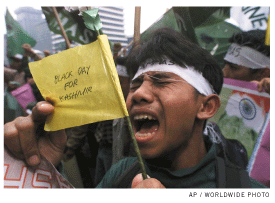
Kashmir: Between High Rocks and Hard Places
India’s first prime minister, Jawaharial Nehru, referred to Kashmir in his writings as “dream-like and unreal, like the hopes and desires that fill us and so seldom find fulfillment.” The object of Nehru’s desire—a mountainous, 86,000-square mile territory between India and Pakistan—has become the obsession of those two nations at a cost of tens of thousands of lives during the past decade alone.
Given that both countries maintain claims to all of Kashmir and raised the stakes with “tit-for-tat nuclear tests” in 1998, Dr. Sugata Bose, professor of history at Tufts University, stated: “There can be no solution to the Kashmir conflict if its people are left out in the cold.” Bose’s appeal for self-determination was backed up by his colleague at Tufts (and his co-author on Modern South Asia: History, Culture and Political Economy), Dr. Ayesha Jalal.
“If you want peace, and not simply the peace of the graveyard,” Jalal said, “the obsessive dilation instate-sponsored nationalism, whether of the Indian or the Pakistani variety, must be exorcised. The focus has to be on human beings, not territory.” One must concede to the people of Kashmir “the elementary right to choose whether to form a union at all, and, if so, with whom.”
Since 1947 the predominantly Muslim territory has been partitioned, with about two-thirds forming the northern Indian states of Jammu and Kashmir and the remaining third, called Azad Kashmir, controlled by Pakistan. Over the past decade, Muslim separatists have renewed their efforts to make the territory part of Pakistan, resulting in the massive deployment of Indian security troops and violent struggles between troops and pro-separatist demonstrators.
“The attempt to impose centralized state authority from above by force and fear on the regions has obviously failed,” Bose contended. “The time has come for the realization to dawn, that a free and flexible union forged from below may well prove in the end to be a stronger and longer lasting union.”
To achieve an enduring peace in this region, he added, leaders must first rule out “deceptive short cuts.” One foolish solution favored by some, he said, is the acceptance of the 1971 boundary known as the “line of control” as the international border between India and Pakistan—an idea which is “unacceptable to the people who straddle this line.
“In the age of tumbling walls and vanishing frontiers,” Bose said, “nothing can be more incongruous than turning the cease-fire line of an inconclusive war into an international border with barbed-wire fencing.”
Another proposal, “even more ill-considered,” would “trifurcate the troubled regions along major sub-regions: Muslim-majority Kashmir, Hindu-majority Jammu and Buddhist majority Ladakh.” According to Bose, “This scheme reproduces lock, stock and barrel, the British colonial penchant for predefining majorities and minorities based on the religious distinction, which has been the principle cause of late-colonial and post-colonial misery from India to Palestine to Ireland. It negates the possibility of democracy, which would require political majorities to be earned and not handed out on prefabricated religious platters.” It also leaves “vulnerable” minorities in each sub-region, offering “an incentive to ‘religious cleansing.’”
Both Bose and Jalal argued that the key to peace in the region lies in expanding strict notions of sovereignty to include layers of power, as existed during much of Kashmir’s precolonial history.
While South Asians may have “learned the modern concept of unitary sovereignty from their British colonial masters,” said Bose, “it would seem that the British themselves have, by now, lost faith in the concept of monolithic sovereignty,” as witnessed by the Good Friday agreement on Northern Ireland and recent cooperative ventures between Britain and Ireland, centered around their participation in the European Union.
“Is there any reason,” Bose asked, “why India and Pakistan, beset by the ghosts of Mountbatten, should cling to a colonial definition of sovereignty on the question of Kashmir, and goad their citizenry in the name of territorial nationalism to the path of mutually assured destruction?”
According to Jalal, the Kashmir conflict is rooted in the history of decolonization in the Indian subcontinent, and can’t be explained by stereotypical notions of “ancient hatreds or even the catch-all label of ethnicity.” More recently, a combination of the India-Pakistan rivalry and Cold War strategic jockeying forestalled a possible independence for Kashmir in the decade following World War II.
Jalal said she has observed signs of an “increasing scope both in Pakistan and India to consider new ways of thinking about” the problem of Kashmir, recognizing the “enormous cost to the subcontinent as a whole” if it’s not resolved. “I think the sovereign claims of the two states as they’re currently articulated need to be rethought,” she added. “That doesn’t mean that they cannot have some sort of relationship with Kashmir as well.”
What is clear, she stressed, is that “There is no one-sided solution to Kashmir, short of an all-out war between India and Pakistan.”
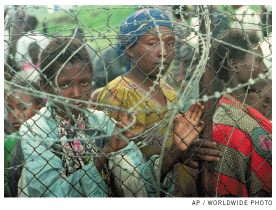
Rwanda: Colonialism’s Bloody Legacy
The two panelists on the Rwanda session shared one area of agreement about the genocidal fighting between the Hutus and the Tutsis: that it had its origins in the years of colonial rule.
“If you took a population census from any one of these places [such as Uganda or Congo] in the colonial period, it would classify the population into two broad overall groups,” explained Mahmood Mandani, the Herbert Lehman Professor of Anthropology at Columbia University and author of Citizen and Subject: Contemporary Africa and the Legacy of Late Colonialism. “One group would be called races; the other group would be called tribes—or, today, ethnicities.” Those who were “non-native, not indigenous,” were “tagged as belonging to a race,” while those who were native to the region were “tagged as belonging to a tribe.”
The law distinguished between those considered “culturally indigenous” (and thus entitled to “customary rights”) and those considered “culturally alien” (and thus “not so entitled”). In most nations in Africa, Mandani noted, “if a particular group settled within the territories before it was made a European colony, it is considered indigenous. If it’s settled after, it is considered not indigenous.”
Because the law in Rwanda did not define any ethnic groups, “all groups were defined as races.” As a result, “the Hutu-Tutsi difference was racialized,” The idea that the Tutsi “belonged to a race which came from outside of Rwanda” goes back to the birth of Belgian colonialism. That distinction helps explain the “explosive character of the crisis,” said Mandani. While ethnicity is an “internal difference” between neighbors, race is an “external difference” with foreigners, and racial conflict is with “those who are seen as usurpers. It is not a conflict at the margins.”
A genocide, he argued, “could not have developed if the Hutu-Tutsi difference were ethnic. A genocide was only possible after the colonial rule which made the Hutu-Tutsi difference racial.”
There were several attempts in the region to change the classification, Mandani noted. The second republic that came into power in 1973 under President Juvenal Habyarimana reclassified the Tutsi legally from a race to an ethnic group, but it had no solution for the Tutsi refugees of the war of 1959, who thus became “politically homeless.”
When the October 1990 invasion, triggered by events in Uganda, took place, the Hutu “demanded that the Tutsi be reclassified as a race and not as an ethnic group,” arguing that the Tutsi were not indigenous but a “race foreign to Rwanda.” And when the Tutsi were massacred, they were thus “killed as a race, not as an ethnic group,” and as a “people not indigenous to Rwanda” who were nonetheless portrayed as being “intent on taking power.”
The experience of the Tutsi in the Great Lakes region of central Africa, said Mandani, “raises an important question about minority fears in a democracy. Rwanda gives us a situation of a guilty majority and a fearful minority and how do you organize a democracy in that situation. I suggest to you again, this is not just a Great Lakes question. It’s also a question in the West.”
Gerard Prunier, a journalist and Africa scholar with the Centre National de la Recherche Scientifique in Paris, listed “four periods in the non-treatment of the Rwanda-based ethnopolitical struggle which has now spread to roughly 30 percent of Africa.” It involved a dense and dispiriting litany of mistakes, misjudgments, ineffectual diplomacy and failures to act, starting with the French government’s decision to give “total support” to the Habyarimana regime in the early 1990s. That decision, he said, came from a “total misreading of the situation” and an assumption that the regime would only kill 30 or 40 people to stay in power, a pattern long practiced by Togolese President Gnassingbe Eyadema. (“That’s perfectly acceptable to Paris, who still support him,” said Prunier, author of The Rwanda Crisis: History of a Genocide. “And we thought guys in Kigali were going to do the same thing. We just didn’t dream they would kill 800,000.”)
But the deeper problem lies in the fact that Africa—like central Asia and the Middle East—is made up of nations in which clear borders did not exist before 1885. “There were populations, not nation-states,” Prunier noted. “And the so-called states that we have had” since 1945 or 1960 “are largely abstract constructions—they’re lines drawn on the map.
“When we talk about failed states—because this has become now a very common term to talk about places like Sierra Leone or Somalia—we tend to forget that these failed states never existed very much in the first place.”
The nation-state, he pointed out, “is not the only form of social organization, either political or otherwise, that has existed on earth.” Until recently, a people could exist without borders or maps, he said, citing the example of the Somalis, whom he described as a people, not a nation-state. “They have total coherence in terms of language, in terms of customs, in terms of religions. They never bothered about borders for the simple reason that they’re just like the Mongols: they’re nomads. That doesn’t work in our world anymore.” Given our desire to have an international world order, “we all like to have all these neat little pigeonholes, regardless of what is inside.”
“What we’re witnessing,” he added, “is the very slow-motion struggle to see emerging nation-states in an enormous area of the world—spanning Central Asia, the Middle East and Africa—where such constructs did not exist.” That process is likely to last for “probably the best part of the next century, at least, and it will cause enormous amounts of suffering.”
In the meantime, he said: “We’re not coping. We’re simply looking at it and trying to feel good by pretending to do something, mostly so we don’t get too disturbed by unpleasant images on the TV screen when we’re having dinner. But the political process that is at work under our eyes is not something that we’re willing to cope with, for a variety of very simple reasons.” Without the strategic interest once provided by the Cold War, and without economic interest (since much of the oil and natural gas can be found offshore), he asked rhetorically: “Why should we care? And we don’t care.”
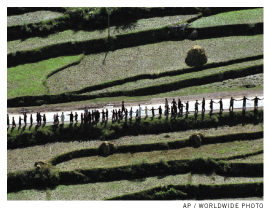
Peace-Building: How to Begin the Healing
If
the first session examined the nature of the ethnopolitical ailment, then
the last was “designed to move us from a diagnosis to treatment and prevention,”
in the words of panel chair Samuel Preston, the Frederick J. Warren Professor
of Demography who serves as dean of SAS. Prevention requires planning,
and as Donald Horowitz—author of Ethnic Groups in Conflict and
professor of law and political science at Duke University—acknowledged,
it is debatable whether any constitutional design can “really be put into
place as planned.” But, he quickly added, that does not mean that the
“design issue is irrelevant.”
Since consociational
democracy is the “most frequently prescribed approach to constitutional
design for divided societies,” and one that “relies on group leaders to
get together and make a deal,” Horowitz listed some typical aspects of
the design. They usually include proportional representation of ethnically
based political parties and cabinet appointments; a proportional allocation
of government positions and finances to the groups and group members;
mutual group vetoes on important issues; and an allocation of “considerable
cultural autonomy to the groups over questions like education and language.”
Among the problems
with consociational democracy, Horowitz suggested, are that it’s “motivationally
challenged,” since leaders are seldom “more moderate or less ethnocentric
than their followers.” And while the desire to enter into a coalition
is a “plausible motive” for a minority group and its ethnically based
party that would otherwise be in opposition, “it’s not such a plausible
motive for a majority group and its ethnically based party.”
Although the
notion of cultural autonomy “implies equal weight to each culture,” he
noted, cultural issues are “proxies for the main contested issues of severely
divided societies: who owns the state, which group is superior, how people
will be treated and who will get ahead.”
Given the bargaining
and compromise that inevitably accompany the designing of a constitution,
“you can’t implement a whole design,” Horowitz argued. For one thing,
“majorities want majority rule” while “minorities want guarantees,” which
often leads to “incoherent compromise,” as does the “multiplicity of participants
with many different goals.” Foreign consultants are also more likely to
encourage compromise, “because they believe that any solution is better
than none—after all, they don’t have to live with it.”
Societies that
are “severely divided,” he maintained, need to look to similarly problematic
societies that have made some progress, “not to societies that look harmonious
or very successful.” In the 1950s and ’60s, Horowitz noted, the Tamils
of Sri Lanka “wanted to make Sri Lanka into an Asian Switzerland,” despite
the vast differences between the populations of the two countries. The
model was not useful for Sri Lanka.
Despite the risk
of “retrogression”—one side manipulating boundaries for political purposes,
which can “easily undo the effects of an accommodative electoral arrangement”—Horowitz
cast his lot with the “incentives” or “vote-pooling” approach, which was
used to good effect in Malaysia, among other places.
“Even after there
were changes in constituency delimitation that disadvantaged the Chinese
minority, it remained possible for the Malays to be divided; and when
the Malays are divided, Chinese votes can help determine the outcome,”
he noted. “And when Chinese votes determine the outcome, politics become
suddenly far more conciliatory than it would otherwise be—and this is
reflected both in politics and policy.”
For many nations
and peoples, “traumatic loss dominates their memory of history,” pointed
out Joseph Montville, the former U.S. diplomat. Those losses and wounds
“constitute the burdens of history and the enduring sense of injustice
that makes peace-building so difficult for traditional diplomats and political
leaders.” The refusal of aggressors to acknowledge the pain they’ve inflicted
“creates an overwhelming sense of injustice in the victims,” he added,
and keeps them “highly suspicious and on permanent alert for future acts
of aggression and violence.” It also makes them “strongly resistant to
pressures to make peace” until the aggressors “acknowledge the victims’
losses and ask forgiveness for their violence.”
As with individual
victims of trauma, “peoples and nations require complex healing processes
to get beyond their psychological and physiological symptoms to become
full partners in reconciliation and peace-building.”
Montville quoted
psychologist Judith Lewis Herman, author of Trauma and Recovery,
who wrote: “The telling of the trauma story thus plunges the survivor
into profound grief, which is the most necessary and the most dreaded
task of this stage of recovery. But it is a stage of recovery, and storytelling
is critical.”
Dr. Pamela Reynolds,
professor of social anthropology at the University of Capetown, played
an active role in South Africa’s Truth and Reconciliation Commission (TRC),
taking part in debates and public hearings and co-authoring a statement
detailing the commission’s research. The TRC’s report concluded that 3.5
million people—90 percent of them African— suffered directly from Apartheid;
Reyolds’ work confirmed that South Africa’s youth bore the brunt of human-rights
violations.
The TRC, she
said, “took two paths, one to examine the perpetrators of violence and
one to hear the victim.” One of its aims was to “prevent the recurrence
of violence,” she said, explaining that it was thus partly “an experiment
in the control of human aggression and to understand and encode incidence
of violence and to heal via acknowledging damage.” That “bearing witness,”
she added, “was seen as integral to the process of acknowledgment. It
emerged from a negotiated settlement and was accompanied by a constitutional,
political and economic reform.”
Not all of the
victims gave testimony, especially the young fighters, who according to
Reynolds rejected being labeled “victims” and said they wanted justice,
“not a forum for storytelling.”
For those considering
replicating the TRC in other countries, she advised that “any move after
conflict should be based on knowing enough as a foundation for inquiry
for intervention or recommendation,” and stressed that “any action should
be done not with a compassion of pity but with the aim of establishing
and formulating the requirements of freedom and its concrete conditions
in the effective reality of modernity.”
Her own attitude
toward the TRC, she said, was one of “ambivalence.” She acknowledged that
it was “successful without doubt” in documenting the depth and breadth
of physical and other violations under Apartheid, “and that’s enormously
important, especially in a Third World country.” She also agreed with
those who believe that the presence of the TRC may well have helped end
the conflict.
But she did have
two concerns: “One, that truth commissions can be substitutions for what
ought otherwise to have been done or what might otherwise have been done,”
and can be about “conciliation, propitiation, mediation and mollification
instead of restitution, repair and renewal.” The other is that they can
“disassemble justice.” While it’s impossible to have individual justice
for everyone, “nevertheless, to have no trials or any quasi-legal hearings”
and “no clear pattern … in giving amnesty,” she said, “is hard to accept.”
“I don’t ever
use the term conflict-resolution,” noted Donald Horowitz during
the question-and-answer session. “If the conflict could be resolved, it
wouldn’t be worth the attention that’s lavished on it.” Furthermore, there
are sometimes “conflicting claims to justice” that would be compromised
by terminating them “prematurely.” The goal should be to reduce conflict,
not resolve it, and anyone designing a nation’s political institutions
“should be very hard-headed”—making sure to “provide incentives” for the
inevitably self-interested actors who are going to operate those institutions.
“But if you want
to assess the past,” he acknowledged, “hard-headedness isn’t always the
right orientation. Maybe you need to think a lot more sympathetically
about the plight of other people than you would think about the plight
of institutions. There’s plenty of work to do in these conflicts for people
with different orientations and approaches to problems.”
The Kosovo and Kashmir sections of this article were written by John Prendergast and Susan Lonkevich, respectively.


